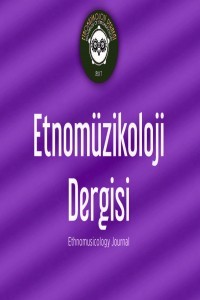Bartok’un Saygun Üzerindeki Etkileri: İşbirliği ve Müzikal Dönüşüm
Bu çalışma, Türk besteci Ahmet Adnan Saygun ile Macar besteci, piyanist ve etnomüzikolog Bela Bartok arasındaki ilişkiyi ve Macar bestecinin 1936 tarihinde Anadolu’da gerçekleştirdiği saha çalısması öncesi ve sonrası bu besteciler arasında gelişen işbirliğinin önemini ve özel durumunu göstermeyi amaçlamaktadır. Bu ilişki, özellikle arastırma gezisi pratiği ve uygulaması açısından büyük önem taşımaktadır. Her ne kadar hem Saygun, hem de Bartok klasik Batı müziği bestecileri olarak tanınıyor olsalar da, etnomüzikoloji çalısmaları her iki bestecinin de yaratıcılığını çok derinden etkilemiştir ve bu derin etkileşim nedeniyle her iki besteci de gerçek anlamda çift müziklidir. Bu iki bestecinin Anadolu saha çalısmaları bulguları, tam 40 yıl sonra aynı yıl basılmıstır ve bu kitaplar, yazarlarının müzik/kültür malzemesine karşı olan estetik, ulusalcı ve pedagojik yaklaşımlarını göstermesi sebebiyle son derece önemlidir. Böylelikle, bu çalışma esas olarak üç konuya odaklanmıştır: bu iki besteci/araştırmacının ulusalcılığın en yuksek noktasında gerçekleştirdikleri işbirliğine olan yaklaşımları ve bu işbirliğinin tarihsel sebeplerinin yanı sıra, halk müziğinin ulusal müziğe dönüşümü yolunda takip edilen metotlar ve süreçlerle beraber, Bela Bartok’un Ahmet Adnan Saygun üzerindeki derin etkilerinin izlerini sürmeyi amaçlamaktadır.
Anahtar Kelimeler:
Bela Bartok, Ahmet Adnan Saygun, Anadolu Saha Çalışması, Halk Müziği, Müzikal Dönüşüm
Bartok’s Influence on Saygun: Collaboration and Transmutations
This paper aims to show the significance and the idiosyncrasies of the collaboration between Turkish composer Ahmet Adnan Saygun and Hungarian composer, pianist, and ethnomusicologist Bela Bartok during and after Bartok’s Anatolian field trip in 1936. This exchange was particularly important because of the praxis of theory and fieldwork. Although both Saygun and Bartok were known for their Western art music compositions, ethnomusicological studies profoundly impacted their creativity; thus, they were truly bi-musical. Their fieldtrip findings, both published at the same time—40 years later, are important documents in terms of their authors’ aesthetic, national, and educational attitude towards the musical/cultural material. Thus, this paper traces their historical motives and approaches to the collaborations in the midst of heightened nationalism; it also shows the methods and the process of the transmutation of peasant music to national music; and ultimately the paper attempts to substantiate the profound effect Bartok had on Saygun.
Keywords:
Bela Bartok, Ahmet Adnan Saygun, Anatolian fieldwork, folkmusic, Transmutation,
___
- Aji, J. (2011). In the Footsteps of Bartok: Folk Influences in the Solo Piano Music of Ahmet Adnan Saygun. Baltimore: The Peabody Institute of the John Hopkins University.
- Akdil, S. (1987). Besteci Ahmet Adnan Saygun. In T. Gogus, Ahmet Adnan Saygun Semineri Bildirileri (pp. 25-27). Izmir: Izmir Filarmoni Dernegi Yayinlari.
- Anderson, B. (1983). Imagined Communities: Reflections on the Origin and Spread of Nationalism . London: Verso.
- Aracı, E. (2001). Ahmet Adnan Saygun Dogu Batı Arasi Muzik Koprusu. Istanbul: Yapi Kredi Kultur Sanat Yayincilik.
- Bartok, B. (1976). Turkish Folk Music form Asia Minor. Princeton and London: Princeton University Press.
- Bartok, B. (1998). The Influence of Peasant Music on Modern Music. In B. C. Elliot Schwartz, Contemporary Composers on Contemporary Music (pp. 72- 79). New York: Da Capo Press.
- Bartok, B., & Suchoff, B. (1997). Bela Bartok Studies in Ethnomusicology. Lincoln: Unoversity of Nebraska Press.
- Curtis, B. (2008). Music Makes Nation: Nationalist Composers and Nation Building in Nineteenth-Century Europe. Amherst, NY: Cambria Press.
- Gazimihal, M. R. (1928). Anadolu Türküleri ve Musikî İstikbâlimiz. İstanbul: Maarif Matbaası.
- Gazimihal, M. R. (1929). Şarkî Anadolu Türkü ve Oyunları, İstanbul Konservatuvarı Neşriyatından Kitap: 2. İstanbul : Evkaf Matbaası.
- Gazimihal, M. R. (1936). Türk Halk Musikilerinin Tonal Hususiyetleri Meselesi
- ISSN: 2619-9572
- Yayın Aralığı: Yılda 2 Sayı
- Başlangıç: 2018
- Yayıncı: Etnomüzikoloji Derneği
Sayıdaki Diğer Makaleler
Siyasi Kültür İçerisindeki Müzik: Eurovision Şarkı Yarışması
Anadolu Coğrafyası Dışındaki Hey Onbeşli Çeşitlemeleri
Bartok’un Saygun Üzerindeki Etkileri: İşbirliği ve Müzikal Dönüşüm
Osmanlı Hareminde Kadın Sazende ve Saz Tasvirinin İncelenmesi
Jeff Todd TITON, Çevirmen: Göksal ÖZTÜRK
21. Yüzyılda Çift Müzikliliği Yeniden Değerlendirmek: Bir Göçmenin Bakışı
